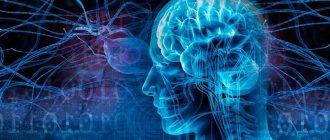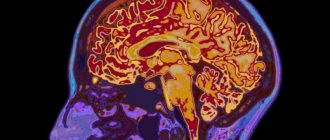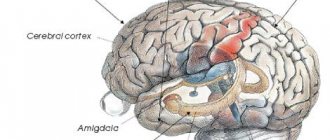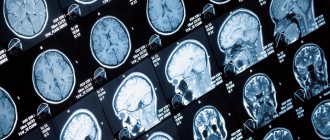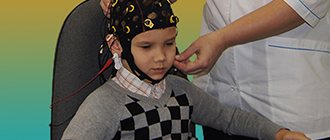In addition to the irreversible death of a person - his biological death, the moment of a person’s death is also recognized as the moment of the death of his brain. This is a very difficult moment for the relatives of the dying person, as their loved one’s heart continues to beat, and breathing is supported by a ventilator, which creates the illusion of continuing life and gives false hope of recovery. However, despite the ability of modern medicine to maintain the functioning of the heart and lungs for a long time, a person is, in fact, already dead. This corresponds to both a medical and legal point of view, according to which a person is declared dead when all brain functions are completely and irreversibly recorded during a beating heart and artificial ventilation of the lungs (Part 2 of Article 66 Federal Law of November 21, 2011 No. 323- Federal Law “On the fundamentals of protecting the health of citizens in the Russian Federation”).
Formation of a consultation of doctors to establish a diagnosis of brain death
The diagnosis of brain death is entrusted to a council of doctors from the medical organization in which the patient is located.
Council of doctors - a meeting of several doctors of one or more specialties, necessary to establish the patient’s health status, diagnosis, determine the prognosis and tactics of medical examination and treatment, the advisability of referral to specialized departments of a medical organization or another medical organization and to resolve other issues in cases provided for by law .
The council of doctors is convened by the attending physician.
There are special requirements for the composition of the council.
On the one hand, it is strictly prohibited to include in the council of doctors specialists involved in the removal and transplantation (transplantation) of organs and (or) tissues (Part 3 of Article 66 of the Federal Law of November 21, 2011 No. 323-FZ “On the Fundamentals of Health Protection citizens in the Russian Federation").
Article 9 of the Law of the Russian Federation dated December 22, 1992 No. 4180-1 “On Transplantation of Human Organs and (or) Tissues” prohibits the participation in such a council of transplantologists and members of teams providing the work of the donor service and paid by it.
However, since the removal of organs of the deceased for transplantation must be carried out promptly, the donation coordination department is informed by medical organizations about the receipt or availability of potential donors, and the functions of the donation coordination department include pharmacological preparation and conditioning of potential donors after death is declared and the removal operation is carried out cadaveric organs and (or) tissues (Order of the Ministry of Health of Russia dated October 31, 2012 No. 567n “On approval of the Procedure for providing medical care in the field of surgery (transplantation of human organs and (or) tissues)”).
However, specialists from the Donation Coordination Department and the Transplantation Department are not allowed to directly participate in the consultation to establish the diagnosis of brain death.
On the other hand, an anesthesiologist-resuscitator and a neurologist with at least five years of experience in their specialty are required to participate in the consultation (Part 3 of Article 66 of the Federal Law of November 21, 2011 No. 323-FZ “On the fundamentals of protecting the health of citizens in Russian Federation").
The rules for determining the moment of death of a person, approved by Decree of the Government of the Russian Federation of September 20, 2012 No. 950, establish more stringent requirements: an anesthesiologist-resuscitator and a neurologist must have at least 5 years of experience in the intensive care unit and resuscitation department.
This restriction does not seem entirely justified from a legal point of view - due to a direct contradiction to the norm of federal law, and is also difficult to implement in practice. Thus, the rules for organizing the activities of the intensive care unit for the adult population and the recommended staffing standards for such a department, approved by order of the Ministry of Health of Russia dated November 15, 2012 No. 919n, do not imply the work of a neurologist in such a department. An anesthesiologist-resuscitator, in addition to the intensive care unit, may have relevant experience working in other structural units providing medical care in the field of anesthesiology and resuscitation.
Thus, despite the desire of the Government of the Russian Federation to involve only experienced doctors in the consultation, the requirement of clause 3 of the Rules for determining the moment of death in terms of the presence of a neurologist and an anesthesiologist-resuscitator with at least 5 years of experience in the intensive care and resuscitation department a person seems excessive and difficult to implement.
The procedure for establishing the diagnosis of human brain death, approved by order of the Ministry of Health of Russia dated December 25, 2014 No. 908n, establishes an expanded composition of the medical council for establishing the diagnosis of brain death.
In addition to the specialists already listed, the council of doctors includes:
- attending physician appointed by the head of the department (center) of anesthesiology and resuscitation, resuscitation and intensive care unit, working around the clock. Since the staff of these departments from medical positions mainly includes the positions of anesthesiologists-resuscitators, then with a high degree of probability the attending physician will be the same anesthesiologist-resuscitator;
- a pediatrician with at least five years of experience in the specialty - when diagnosing brain death in children. When a diagnosis of brain death is made in children, a neurologist included in the council of doctors must have experience in providing medical care to children;
- a functional diagnostics doctor with at least five years of experience in the specialty - to conduct an electroencephalographic study;
- a radiologist with at least five years of experience in the specialty - to conduct contrast digital subtraction panangiography of the four main vessels of the head (common carotid and vertebral arteries).
Thus, only experienced and qualified medical specialists are invited to participate in a consultation of doctors to establish a diagnosis of brain death. who have no interest in establishing a diagnosis of brain death.
Conditions for starting the procedure for establishing a diagnosis of human brain death
The procedure for diagnosing human brain death is postponed:
- In the presence of intoxication, including drugs. In this case, the procedure begins after four half-lives of the drug or other substance that caused intoxication have elapsed;
- With previous use for medicinal purposes of drugs for anesthesia, analgesics, narcotic drugs, psychotropic substances, muscle relaxants, other drugs that depress the central nervous system and neuromuscular transmission, as well as drugs that dilate the pupils. In this case, the procedure begins after at least one half-life has elapsed from the moment of their last administration.
These restrictions are established for a reason, but are due to the fact that some types of chemicals (including certain medications) can plunge the human body into a deep coma. In such cases, in order to exclude even the slightest possibility of error, the procedure for diagnosing human brain death should be postponed.
Before starting the procedure for diagnosing human brain death, during examination of the patient, the rectal temperature must be consistently above 34 ° C, systolic blood pressure, including during intensive care, in adults must not be lower than 90 mm Hg, in children depending by age: not lower than 75 mm Hg. (from 1 to 3 years), not lower than 85 mm Hg. (from 4 to 10 years), not lower than 90 mm Hg. (from 11 to 18 years old).
Before starting the procedure for diagnosing human brain death, a council of doctors must establish the absence of signs and data:
- about intoxications, including drugs;
- about primary hypothermia;
- about hypovolemic shock;
- about metabolic and endocrine comas;
- on the use of drugs that depress the central nervous system and neuromuscular transmission, as well as drugs that dilate the pupils;
- about infectious brain lesions.
The protocol for establishing a diagnosis of brain death includes:
- information about the absence of signs and data,
- information about rectal temperature values,
- information about systolic blood pressure values.
Only if the specified conditions are met in their entirety, a council of doctors can begin the procedure for establishing a diagnosis of brain death.
Determining the presence of clinical criteria for human brain death
The procedure for diagnosing human brain death begins with determining the presence of clinical criteria for human brain death in the following sequence:
- complete and persistent lack of consciousness (coma);
- atony of all muscles (the presence of spinal automatisms is not a sign of the absence of muscle atony);
- lack of response to strong painful stimuli in the area of the trigeminal points and any other reflexes that close above the cervical spinal cord;
- immobility of the eyeballs, lack of reaction of maximally dilated pupils (for adults, pupil diameter is more than 5 mm, for children - more than 4 mm) to direct bright light;
- absence of corneal reflexes;
- absence of oculocephalic reflexes;
- absence of oculovestibular reflexes;
- absence of pharyngeal and tracheal reflexes;
- lack of spontaneous breathing, confirmed by a positive apneic oxygenation test.
The determination of clinical criteria for human brain death is terminated if the presence of any clinical criterion is not confirmed, including if it is unilaterally determined.
The protocol for establishing a diagnosis of brain death includes:
- information on confirmation of the presence of clinical criteria for human brain death,
- information about the presence or absence of injuries to the face, one or both eyeballs, the cervical spine, perforation of one or both eardrums, chronic obstructive bronchopulmonary pathology, affecting the determination of clinical criteria for human brain death,
- other information related to the procedure for diagnosing human brain death.
Thus, if the presence of at least one clinical criterion for human brain death is not confirmed, the procedure for establishing a diagnosis of brain death is terminated.
Prospects for treatment
The current stage of development of medicine does not provide any possibilities for curing a patient after brain death. In some cases, it is possible to recover from states similar to brain death, for example from a deep coma, or from a vegetative state (in the case of incomplete decortication).
As for brain death itself, the terminology itself implies the irreversibility of this condition, so until recently there was no research at all into the possibilities of therapy.
The possibility of a brain transplant remains purely hypothetical for modern medicine - among other problems, it is almost impossible to imagine the availability of a donor organ for such an operation.
Only in 2021, research in the field of curing brain death using modern biomedical technologies began to be carried out by several groups of American scientists, but the success of such work, even in the long term, seems very doubtful.
Establishing a diagnosis of brain death based on the results of the observation period
After initial confirmation of the presence of all clinical criteria, the council of doctors can decide to establish an observation period. If an observation period is established, the presence of clinical criteria is re-determined every 6 hours and at its end. The apneic oxygenation test to determine the absence of spontaneous breathing during the observation period and at its end is not repeated.
Table 1. Establishing a diagnosis of brain death based on the results of the observation period
| Patient category | Duration of observation period, hour | Starting point | Criteria for diagnosing brain death | Termination criterion |
| Adult patient with primary brain injury | at least 6 | The moment of initial confirmation of the presence of all clinical criteria | The diagnosis of human brain death is established upon initial confirmation of the presence of all clinical criteria and repeated confirmation during the observation period and at the end of the observation period of the presence of all clinical criteria. | When initially determining or re-determining during or at the end of the observation period the presence of clinical criteria for human brain death, the presence of at least one clinical criterion is not confirmed |
| Adult patient with secondary brain damage | at least 24 | |||
| Adult patient with previous intoxication | at least 72 | |||
| Children with primary brain damage | at least 12 | The moment of establishing the absence of bioelectrical activity of the brain according to the results of an EEG study | The diagnosis of human brain death is established upon initial confirmation of the presence of all clinical criteria, establishment of the absence of bioelectrical activity of the brain based on the results of an EEG study, and repeated confirmation during the observation period and at the end of the observation period of the presence of all clinical criteria. | When initially determining or re-determining during or at the end of the observation period the presence of clinical criteria for human brain death, the presence of at least one clinical criterion is not confirmed |
| Children with secondary brain damage | at least 24 | |||
| Children with previous intoxication | at least 72 | |||
| Adult patient with primary brain injury in the absence of the ability to determine one or more clinical criteria for human brain death | at least 6 | The moment of detection of the absence of filling of the intracerebral arteries with a contrast agent according to the results of a single contrast digital subtraction panangiography of the four main vessels of the head (common carotid and vertebral arteries) | The diagnosis of human brain death is established upon initial confirmation of the presence of all clinical criteria that can be determined, establishing the absence of bioelectrical activity of the brain according to the results of an EEG study, identifying the absence of filling of intracerebral arteries with a contrast agent according to the results of a single contrast digital subtraction panangiography of the four great vessels of the head (common carotid and vertebral arteries) and re-confirmation during the observation period and at its end of the presence of clinical criteria that can be determined. | When initially determining or re-determining during or at the end of the observation period the presence of clinical criteria for human brain death, the presence of at least one clinical criterion that was determined is not confirmed. |
| Children with primary brain damage in the absence of the ability to determine one or more clinical criteria for human brain death | at least 12 | |||
| Adult patients and children with secondary brain damage in the absence of the ability to determine one or more clinical criteria for human brain death | at least 24 | |||
| Adult patients and children with previous intoxication in the absence of the ability to determine one or more clinical criteria for human brain death | at least 72 |
By decision of the council of doctors, the observation period can be terminated early, and double contrast digital subtraction panangiography of the four main vessels of the head (common carotid and vertebral arteries) must be performed.
Prevention of the development of intravital extreme coma
Since this condition occurs secondary to other pathologies and diseases, measures to prevent it mainly come down to timely diagnosis and adequate treatment of the causative disorders.
It is important for the patient to follow the doctor’s recommendations, undergo the necessary examinations on time, and not violate the rules for taking prescribed medications.
In some cases, when there are serious reasons to fear the development of life-threatening conditions, it would be appropriate for the attending physician to pay attention to drugs that activate brain activity (for example, nootropic drugs).
Of course, this will not eliminate such a threat, but it may somewhat reduce it, or increase the time during which the patient can receive help.
Establishing a diagnosis of brain death based on the results of panangiography of the vessels of the head
Contrast digital subtraction panangiography of the four main vessels of the head (common carotid and vertebral arteries) (hereinafter referred to as panangiography) is performed to determine the state of the patient’s cerebral circulation.
The decision to conduct double panangiography is made by a council of doctors:
- after initial confirmation of the presence of all clinical criteria in adult patients;
- after establishing the absence of bioelectrical activity of the brain based on the results of an EEG study in children, as well as in adult patients and in children in the absence of the possibility of determining one or more clinical criteria.
In the case of double panangiography, the interval between studies should be at least 30 minutes.
The value of mean arterial pressure during panangiography should be no lower than 80 mm Hg in adult patients, and no lower than physiological age values in children: 45 mm Hg. (1 year), 55 mm Hg. (from 2 to 5 years), 65 mm Hg. (from 6 to 10 years), 75 mm Hg. (from 11 to 18 years old).
If, during panangiography, it is revealed that none of the intracerebral arteries are filled with a contrast agent, then this indicates cessation of cerebral circulation.
The diagnosis of brain death in adult patients, if it is possible to determine all clinical criteria for human brain death, is established upon initial confirmation of the presence of all clinical criteria and identification of the absence of filling of intracerebral arteries with a contrast agent based on the results of double contrast digital subtraction panangiography of the four main vessels of the head (common carotid and vertebral arteries ).
The diagnosis of brain death in children is established upon initial confirmation of the presence of all clinical criteria, establishing the absence of bioelectrical activity of the brain according to the results of an EEG study and identifying the absence of filling of the intracerebral arteries with a contrast agent according to the results of double contrast digital subtraction panangiography of the four great vessels of the head (common carotid and vertebral arteries) .
The diagnosis of brain death in adult patients and in children in the absence of the ability to determine one or more clinical criteria for brain death is established:
- upon initial confirmation of the presence of all clinical criteria that can be determined, establishing the absence of bioelectrical activity of the brain during an EEG study and identifying the absence of filling of the intracerebral arteries with a contrast agent based on the results of double contrast digital subtraction panangiography of the four main vessels of the head (common carotid and vertebral arteries);
- upon initial confirmation of the presence of all clinical criteria that can be determined, establishing the absence of bioelectrical activity of the brain based on the results of an EEG study, identifying the absence of filling of intracerebral arteries with a contrast agent based on the results of a single contrast digital subtraction panangiography of the four main vessels of the head (common carotid and vertebral arteries) and reconfirmation during the observation period and at its end of the presence of clinical criteria that can be determined.
If the results of panangiography reveal that at least one intracerebral artery or part thereof is filled with a contrast agent, the procedure for diagnosing human brain death is stopped.
The results of contrast digital subtraction panangiography of the four main vessels of the head (common carotid and vertebral arteries) are attached to the protocol for establishing the diagnosis of brain death.
If the body is accidentally discovered
If an ambulance team finds a victim without signs of life, doctors have no information how long he remains in this condition. In the absence of cadaveric spots, doctors cannot confirm in the field that biological death has occurred. In this case, resuscitation is mandatory.
Resuscitation measures include artificial ventilation of the lungs and closed heart massage. If there is bleeding, it is important to stop it so the victim does not bleed out. Damage to a large artery or head is extremely dangerous. If resuscitation measures are carried out correctly, a person can be brought back to life.
Application of the electroencephalographic study method to establish the diagnosis of brain death
An EEG study is used to make a diagnosis of brain death:
- in children, if it is possible to determine all clinical criteria for brain death;
- in adult patients and in children in the absence of the ability to determine one or more clinical criteria for human brain death.
At the same time, establishing the absence of bioelectrical activity of the brain based on the results of an EEG study is not in itself an independent criterion for establishing a diagnosis of brain death and is used in conjunction with the main methods - observation and panangiography of the vessels of the head.
To perform EEG studies, encephalographs with at least 8 recording channels are used. An electroencephalogram (hereinafter referred to as EEG) is recorded and analyzed in bipolar and monopolar leads.
The absence of bioelectrical activity of the brain is evidenced by an EEG recording in which the amplitude of activity from peak to peak does not exceed 2 μV, subject to the following conditions:
- recording is carried out from scalp electrodes with a distance between them of at least 10 cm in adult patients and at least 8 cm in children;
- at least 8 electrodes are used, located according to the “10-20%” system, and 2 ear electrodes;
- the interelectrode resistance must be at least 100 Ohms and no more than 10 kOhms;
- the safety of switching and the absence of unintentional or intentional creation of electrode artifacts is determined;
- recording is carried out on encephalograph channels with a time constant of at least 0.3 seconds. with a sensitivity of no more than 2 µV/mm (the upper limit of the frequency bandwidth is not lower than 30 Hz).
The electrical silence of the cerebral cortex under these conditions should remain for at least 30 minutes of continuous recording. If there is doubt about the electrical silence of the brain, repeated EEG registration is necessary.
Assessing EEG reactivity to light, loud sound and pain:
- the total stimulation time with light flashes, sound stimuli and painful stimuli should be at least 10 minutes;
- the source of flashes fired at a frequency of 1 to 30 Hz should be located at a distance of 20 cm from the eyes;
- the intensity of sound stimuli (clicks) is 100 dB, the speaker is located near the patient’s ear;
- stimuli of maximum intensity are generated by standard photo- and phonostimulators;
- For painful stimulation, strong injections with a sterile needle are used on the patient’s skin.
To establish the absence of bioelectrical silence of the brain, EEG recording by telephone or methods of automatic, mathematical (spectral, coherent) EEG analysis should not be used.
If the results of an EEG study do not establish the absence of bioelectrical activity of the brain, the procedure for diagnosing human brain death is terminated.
The results of the EEG study are attached to the protocol for establishing the diagnosis of brain death.
Types and stages of violation
In medical practice, there are three degrees of degenerative disorders in the brain:
- Mild degree
. It is characterized by a loss of professional skills and apathy to what is happening around. The patient is not interested in subjects that were previously considered his hobby. In this degree of illness, orientation and consciousness are preserved. - Average degree
. The patient copes with personal hygiene skills, but may forget the rules for using household appliances. Such people often need help; leaving them unattended is dangerous. - Severe degree
. Patients lose orientation in space and are unable to serve their own needs.
Degenerative diseases of the brain can be expressed in a total or lacunar form.
- The total form
of the disorder is characterized by poor emotionality and apathy. Personality degradation occurs. - The lacunar (partial) form
is characterized by impairment in short-term memory. But the “core of personality” remains.
The course of the disease occurs in stages:
- Predementia
is a stage of the disease characterized by memory loss, absent-mindedness and apathy. The ability to think abstractly decreases. Thus, disturbances affect fresh layers of memory. - Early degeneration
(the second stage of the disease) is characterized by more pronounced disorders. The progressive disease is expressed in impaired motor activity and incoherent speech. The patient cannot always express his thoughts, his movements are absurd, but at the same time remnants of memory and sanity are preserved. - Moderate dementia
(third stage) manifests itself in the fact that a person begins to confuse words, does not recognize his loved ones, and partially loses reading and writing skills. There may be elements of delusion. An elderly person is able to leave home, but it is not possible for him to return back due to impaired consciousness. In addition to these symptoms, patients cease to control the natural needs of the body. - After these stages, severe dementia
. The person practically does not speak, does not get out of bed and loses the ability to perform the most basic movements. In this case, exhaustion of the body occurs. Death occurs as a result of pneumonia or bedsores that arise in such conditions.
Making a diagnosis of human brain death
Establishing a diagnosis of human brain death is documented in a protocol in the form approved by order of the Ministry of Health of Russia dated December 25, 2014 No. 908n.
The protocol for establishing a diagnosis of brain death includes:
- information about the absence of signs and data on intoxication, including drugs; about primary hypothermia; about hypovolemic shock; about metabolic and endocrine comas; on the use of drugs that depress the central nervous system and neuromuscular transmission, as well as drugs that dilate the pupils; about infectious brain lesions;
- information about rectal temperature values;
- information about systolic blood pressure values;
- information on confirmation of the presence of clinical criteria for human brain death,
- information about the presence or absence of injuries to the face, one or both eyeballs, the cervical spine, perforation of one or both eardrums, chronic obstructive bronchopulmonary pathology, affecting the determination of clinical criteria for human brain death,
- other information related to the procedure for diagnosing human brain death.
Each page of the protocol is signed by the participants of the council of doctors. The protocol is entered into the patient’s medical documentation. The Protocol is accompanied by the results of an EEG study and contrast digital subtraction panangiography of four great vessels of the head (common carotid and vertebral arteries).
Thus, only experienced and qualified medical specialists are invited to participate in a consultation of doctors to establish a diagnosis of brain death, and the modern procedure for establishing a diagnosis of brain death is regulated in detail by law. If any doubts arise, even the slightest, they, regardless of the stage of the procedure, are interpreted in favor of recognizing the person as alive. Based on this, we can say that current domestic legislation minimizes the risk of forcibly disconnecting a person from life support devices.


